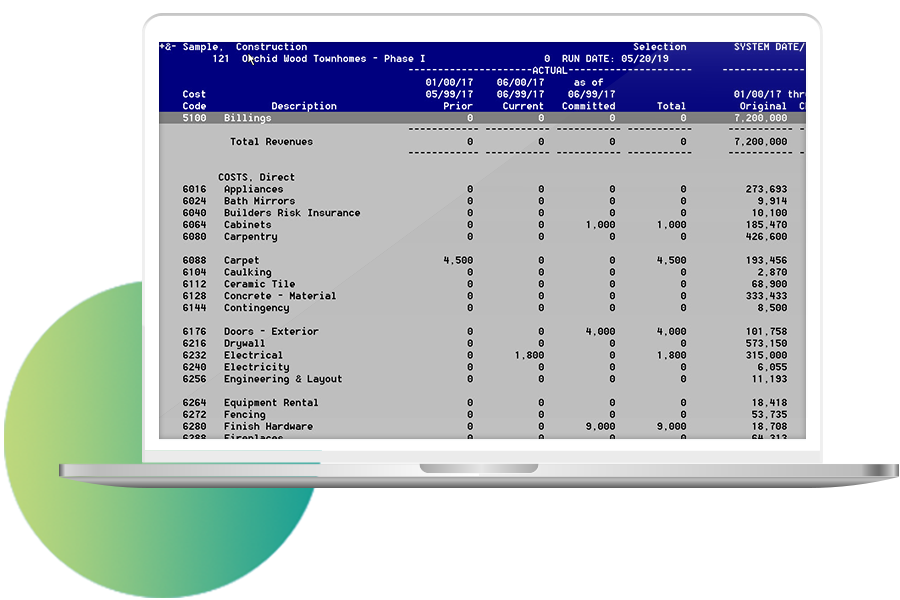- You can generate job cost reports on a “cash,” “accrual,” or “committed” basis (open purchase orders)
- The Plus & Minus linker allows you to easily track costs and revenue by specific job, panel, or phase
- You can maintain the cost of labor, equipment, materials, sub-contractors, overhead, and user-defined costs as they occur
- You can compare the budget with actual cost for specific tasks to track individual phase and cost combinations
- You can produce AIA draw requests (with a spreadsheet or Plus & Minus default documents)
- You can generate contract-in-progress reports for submission to bonding agents
- Single-file eliminates interfacing
- Transaction entry in real-time
- You can track payables by job
- You can track change orders
- You can input budgets from spreadsheet takeoffs or third-party systems

Job Cost Reporting
Job cost, also referred to as contract accounting, generates a fully functional report for each job: budget vs. actual, per square foot, and % of the budget for each line item in the job. You can also include open purchase draws (committed).
Column headings include:
- Actual
- Prior
- Current
- Committed
- Budget
- Original
- Change Order
- Stats
- (Over)/Under
- %
- $/Unit


Sales Doc Writer Draws
You use the Sales Doc Writer Draws to sell work or material and receive payment based on a schedule of draws. Draws can have retentions. When inspectors reduce draws, you can modify draws by issuing an adjustor draw.

Purchase Doc Draw
You use the Purchase Work Doc Writer to purchase work or material and pay for it based on a draw schedule. The Purchase Work Doc Writer has four functions: Quote, Order, Invoice (draw), and Template.
It produces to following documents:
- Quote
- Order
- Invoice (draw)
- Waiver
- Check with no waiver
- Check with waiver

Payment Application
You use Payment Application to track and maintain payment applications to owners, developers, or lenders. Plus & Minus records draws in: Account Receivable – Trade, Account Receivable – Retention, and Revenue – Billings.
Lender/developer inspectors adjust payment applications; hence, it is necessary to adjust a previous application. Plus & Minus also handles Retroactive Adjustments.

Invoice Biller
You use Invoice Biller to bill customers for time worked. Invoice Biller uses Excel as a form writer, and you can carry a separate form for each customer.

Workers’ Compensation
Workers’ Compensation reporting provides you with the ability to record, store, retrieve, and calculate workers’ compensation amounts.
There are two ways to calculate workers’ compensation insurance:
- Classification: one premium rate for each class of work.
- Category: the premium rate is based on the hourly pay rate
You assign each employee a default workers’ comp class, and in Payroll, you can assign workers comp classes based on the type of work performed.

Spreadsheet Generator (Dashboard)
For small jobs, defined as less than ten days from start to finish, the Management Report, Job Cost reporting system is not worth the effort. Spreadsheet Generator is the answer. There are no setup requirements since the sub accounts drive the report. Large jobs report in the same brief format (ten columns or less) as small jobs.

Construction in Progress
- Generate a worksheet of earned profit and over/under billings by job.
- Record an entry to adjust the “Excess” and “Billings” accounts to reflect the percent complete.
- Create a report of earned profit and over/under billings by job to submit to your bonding agency.

Time Sheet
Time Sheet records by employee: Daily time and Per diem expenses & reimbursements. For each employee, you enter: Job and Activity performed on the job.
- Time Sheet drives the Pay Check Writer
- Time Sheet carries information (prevailing wage) to generate a certified payroll
- Export time to 3rd party payroll services, such as ADP
- Import time from Excel or Plus & Minus PamClassTime object (user-written systems)
